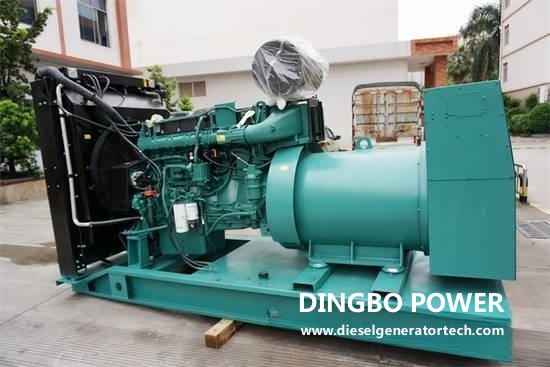A diesel generator is a device used to generate electricity for any number of applications, from small power tools to large industrial applications. A simple explanation for how electricity is generated is that diesel generators operate as a type of electric motor, converting one energy source into another. In this case, a generator works by taking mechanical energy and converting it into electrical energy.
Every diesel generator consists of at least nine different but equally important components. They are: diesel engine, alternator, fuel system, regulator, cooling and exhaust system, lubrication system, charger, control panel, frame of main components, generator parts. To better understand how a generator converts mechanical energy into electrical energy, Guangxi Dingbo Generator Set Manufacturing Co.,Ltd. will study the role of all components of a diesel generator set, starting with the diesel engine.
It's just a basic diesel engine and it's no different than a diesel engine in a car, van, truck, or other large vehicle. This is where the mechanical energy comes from, and the size of the engine matters. If you want a bigger generator output then you need a bigger engine. The bigger the engine, the more electrical output you can produce.
Alternator.
This is essentially the component responsible for generating the power output. Here we see the concept of electromagnetic induction coming into play.
An alternator consists of many complex components, but one of the most critical aspects is the rotor. This is a rotating shaft, driven by mechanical energy provided by an engine, with multiple permanent magnets fixed around it. In doing so, this creates a magnetic field.

This resulting magnetic field surrounds another critical part of the alternator: the stator, which keeps rotating. Simply put, it's a variation of different electrical conductors that are tightly wound around an iron core. This is where things start to get more scientific. According to the principle of electromagnetic induction, if an electrical conductor remains stationary and a magnetic field moves around it, an electric current is induced.
In summary, the alternator absorbs the mechanical energy produced by the diesel engine, which drives the rotor to generate a magnetic field that moves around the stator, which in turn produces alternating current.
Fuel System.
The fuel system mainly consists of a fuel tank with pipes that connect it to the engine. Here, diesel can be supplied directly to the engine, which will then start the entire process described above. The size of the tank ultimately determines how long the generator can stay active.
Dingbo Power's series of silent diesel generators usually come standard with a fuel tank included in the bottom of the generator. If a larger capacity fuel is required, we can design and manufacture a custom extended base tank, or the unit can be attached to an additional freestanding large tank.
For larger generator projects that require the genset to be installed into a sound enclosure, a separate fuel system is usually installed or located inside the enclosure, under the enclosure, or sometimes both.
Stabilizer.
Here we have the most complicated part of the generator. Voltage regulators have one self-evident purpose: to regulate the voltage output. There is too much going on here to explain in this article alone, and we may need a completely separate section to describe the entire voltage regulation process.
Simply put, it ensures that the generator produces electricity at a stable voltage. Without it, you see huge fluctuations depending on how fast the engine is working. Needless to say, none of the electrical equipment we use can handle this erratic power supply. So, this part works its magic to make everything smooth and stable.
Cooling system and exhaust system.
Both components play very important roles, and the good news is that they are easy to understand. The cooling system helps prevent the generator from overheating. Coolant is released from the generator to counteract any extra heat generated by the engine and alternator. The coolant then absorbs all this heat through a heat exchanger and pushes it out of the generator.
The exhaust system works on the same principle as a car exhaust system. It absorbs any gases produced by the diesel engine, takes them into the piping system, and discharges them from the generator set.
Lubrication system.
This part is connected to the engine and pumps oil through it to ensure that everything works smoothly and does not rub against each other. Without it, the engine would fail.
Charger.
All diesel engines need a tiny electric motor to help it function. This little motor needs a battery and needs to be charged. The battery charger can be kept well and fully charged from external power from the generator itself.
Control panel.
This is just where the generator is controlled and operated. On electric starter generators, you'll find a ton of controls here that allow you to do different things or check certain numbers. This could include anything from starter buttons and frequency switches to engine fuel indicators, coolant temperature indicators, and more.
Main assembly frame.
Every generator needs to be contained in some way, and that's the main assembly frame. It houses the generator and all the different parts are built on it. It puts everything together and it can be an open design or closed for added protection and sound attenuation. Outdoor generators are usually mounted in a weatherproof protective frame to prevent damage.
Founded in 2006, Guangxi Dingbo Generator Set Manufacturing Co.,Ltd. is a wholly-owned subsidiary of Guangxi Dingbo Generator Set Manufacturing Co.,Ltd. It is one of the earliest manufacturers of generator sets in China. Dingbo Power has 24 sales and service departments, which provide users with long-term technical advice, free debugging, free maintenance, and free training services. Looking forward to your inquiry, for more details, please contact us with [email protected].
Copyright © Guangxi Dingbo Generator Set Manufacturing Co., Ltd. All Rights Reserved | Sitemap
Update cookies preferences